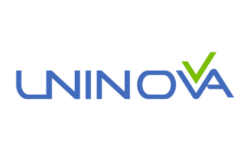Oxide-based neuromorphic devices
About
UNINOVA offers access to the entire value chain related to the design, simulation, fabrication, and characterization of oxide-based neuromorphic devices, mainly memristor-based devices, both on rigid and flexible substrates.
Description
Core competencies offered:
- Physical level simulation of memristor devices adaptable with existing models in SILVACO.
- Design, simulation, fabrication and characterization of 1 memristor-1 TFT small crossbar array (4*4, 2*10,…) &/ large memristor crossbar up to 20*20 or more using in-house clean room processes.
- Printed and solution-processed memristors using various printing techniques, among them XTPL direct printing.
- Optoelectronic memristor devices
- Electrical measurements of only small arrays including quasistatic measurements, Pulse measurements with different schemes for potentiation and depression and other brain-inspired pulsing schemes, using Keithley 4200 SCS.
- Temperature measurement of devices from RT to 80 K using Janis cryogenic probe station.
Major tools:
- Silvaco TCAD suite for physics-based simulation of memristors.
- Tools of electrical measurements: Semiconductor analysers such as Keithley 4200 SCS equipped with C-V (1 KHz-2 MHz) and pulse IV modules, and Janis Cryogenic probe stations equipped with an optical arm to be coupled to various LEDs for optical studies.
- Tools for memristor fabrication and neuromorphic circuit integration, including sputtering, ALD, direct laser writing, etching, and nanoimprint lithography. Printing is available for memristor device fabrication and CPW lines for dynamic studies.
- Failure analysis, including SEM/FIB cross-section analysis, EBIC-based techniques, and STEM and especially XPS for interfacial analysis.
Technical specifications:
Fabrication:
- Glass or flexible substrates (up to 4” size) including high frequency antenna substrates
- Memristor area between 2 µm2 to 100 µm2 and above, depending on processing technology.
Characterization:
- Up to 2” size for SEM/FIB
- Electrical characterization in probe stations – up to 4” substrate and up to 6 I/O pads (beyond that requires PCB integration)
- Optical systems: Visible and IR and UV LEDs, Optical multiplexer, Two LED power units, Optical power meter. All equipment is from Thorlabs.
Case study:
A user needs to access any or several parts of the value chain related to oxide-based neuromorphic devices, including design, simulation, fabrication, and characterization, both on rigid and flexible substrates.
Optional:
https://doi.org/10.1002/aelm.202300286
https://doi.org/10.1039/BK9781839169946-00431
https://doi.org/10.1088/2634-4386/acd4e2
https://doi.org/10.1002/aelm.202200642
https://doi.org/10.1063/5.0073056
Access Provider / Facilities






